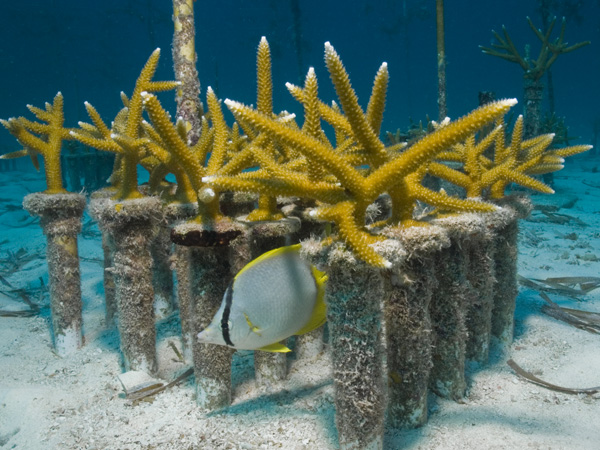‘(How To Grow) A Floating Forest’
In order to understand what’s going on in the video, you’re going to want to read the post below!
One of the most innovative, practical, and functional coral nurseries on the planet can be found just a few miles off the shores of Key Largo. The nursery consists of thousands of neatly organized colonies of the critically important staghorn coral (Acropora cervicornis) grown by the Coral Restoration Foundation (CRF) for the purpose of transplantation back to the reef. Staghorn corals have been decimated by disease and extreme weather here in Florida over the past 30 years, resulting in a seriously degraded reef ecosystem. Fortunately the CRF has developed methods that maximize the growth potential of these corals in their nursery, demonstrating that coral aquaculture is a realistic and effective way to restore beleaguered wild populations.

Before the PVC trees, these cement pedestals were the preferred substrate for coral attachment. The CRF nursery is also home to a wide variety of tropical fish that are quite comfortable around divers.
The Coral Restoration Foundation is the vision of Ken Nedimeyer, an aquaculturist who first laid down roots for the organization in 2000 as an effort to transplant a few cultivated staghorn corals for a 4H project with his daughter. In 2007 they received a Federal stimulus grant which finally allowed Ken to focus on reef rehabilitation and coral aquaculture full time. Over the past decade the CRF has learned to increase their efficiency by developing new methods of aquaculture utilizing very practical techniques, a modest budget, and a mighty DIY spirit.
Early on at the Coral Restoration Foundation nursery, staghorn corals were grown on cinder blocks, but the never-ending battle against competing algae became too time consuming to maintain. Later they developed a system of cement pedestals which cut down on the algal overgrowth. But most recently they have discovered that they can get significantly faster growth rates by suspending the corals from wires in mid-water. Early experiments yielded ‘clothes lines’ of hanging corals, but over time they have settled onto simple PVC ‘trees’. These trees are efficient in maximizing growing space and simple in design; each tree can suspend up to 150 coral fragments in a fraction of the surface area that the pedestals could accommodate. Styrofoam lobster buoys keep the trees suspended, while a tether keeps it anchored to the seafloor.
The Coral Restoration Foundation reproduces their staghorn corals asexually through simple fragmentation. To make a new colony, they simply remove a branch tip from a larger coral. It’s really no different a process than taking a cutting from a plant. They use telephone wire to twist around the coral fragment until it is secured tight. The other end of the wire is then secured and hung from a lateral branch of the tree. The coral will quickly heal its broken end, and its tissue will grow over the wire so that it will eventually become firmly embedded within its skeleton. Once hung, the coral fragment is then free to offshoot branches in 360 degrees while capitalizing on clean mid-water currents. The trees are able to rotate around their axis which ensures even distribution of sunlight and water flow to all the corals. By being suspended up in the water column, the corals are protected against dreaded fireworms that emerge at night to eat the tissue right off the skeleton. The trees also reduce the likelihood of damage from sea turtles and sharks that find the CRF nursery to be a fine place to sleep. Unfortunately the stings from passing mid-water moon jellyfish (Aurelia aurita) are still a cause of occasional mortality.
The Coral Restoration Foundation has what I would call a ‘Dream Team’ of some of the brightest minds in coral aquaculture working to fully realize the mission of restoring Florida’s reefs. But with grant money being ever harder to come by, the CRF is ever more dependent on creative ways to support their goals. If you are a diver, I highly recommend that you volunteer to help the CRF in their mission. Every month or so they offer an underwater tour of their nursery, followed by trips out to the reef to help with the transplantation. This makes for a super cool, educational, and rewarding dive experience that you will get nowhere else. There is even a PADI ‘Coral Restoration’ diver specialty class in the works! Beyond the impressive corals at the nursery, you’ll be amazed at just how many tropical fish there are living amongst the corals, and just how unafraid they are of divers. If you aren’t in a position to lend a helping hand as a diver, I highly recommend that you Adopt-A-Coral and make a financial contribution to support this fantastic organization. With all of our support, I fully expect to see the CRF expanding their nursery operations to other locations in Florida, and elsewhere around the world… where I will go visit them.

Sunlight streams down through the PVC and staghorn branches of a nursery tree.

October 4th, 2011 at 12:48 pm
[…] [Coral Morphologic] Tweet Posted in Reef News | Search More: acropora cervicornis • coral morphologic • Coral Restoration Foundation • coral tree nursery • staghorn coral • video Site Sponsors: […]
October 4th, 2011 at 10:01 pm
[…] From the opening shot showing the aquarium-style ‘coral candy’ of small staghorn coral frags to the long line up of small colonies all growing together on a string, this video of the coral tree nursery is a great documentation of what kinds of innovations are possible when dealing with corals when we toss out the status quo. [Coral Morphologic] […]
October 24th, 2011 at 9:50 am
[…] of man. That is the source of its beauty. To learn more about the CRF and its nursery, check out “(How To Grow) A Floating Forest” by Foord (whom I interviewed in August about the danger posed to a rare hybrid coral by the […]